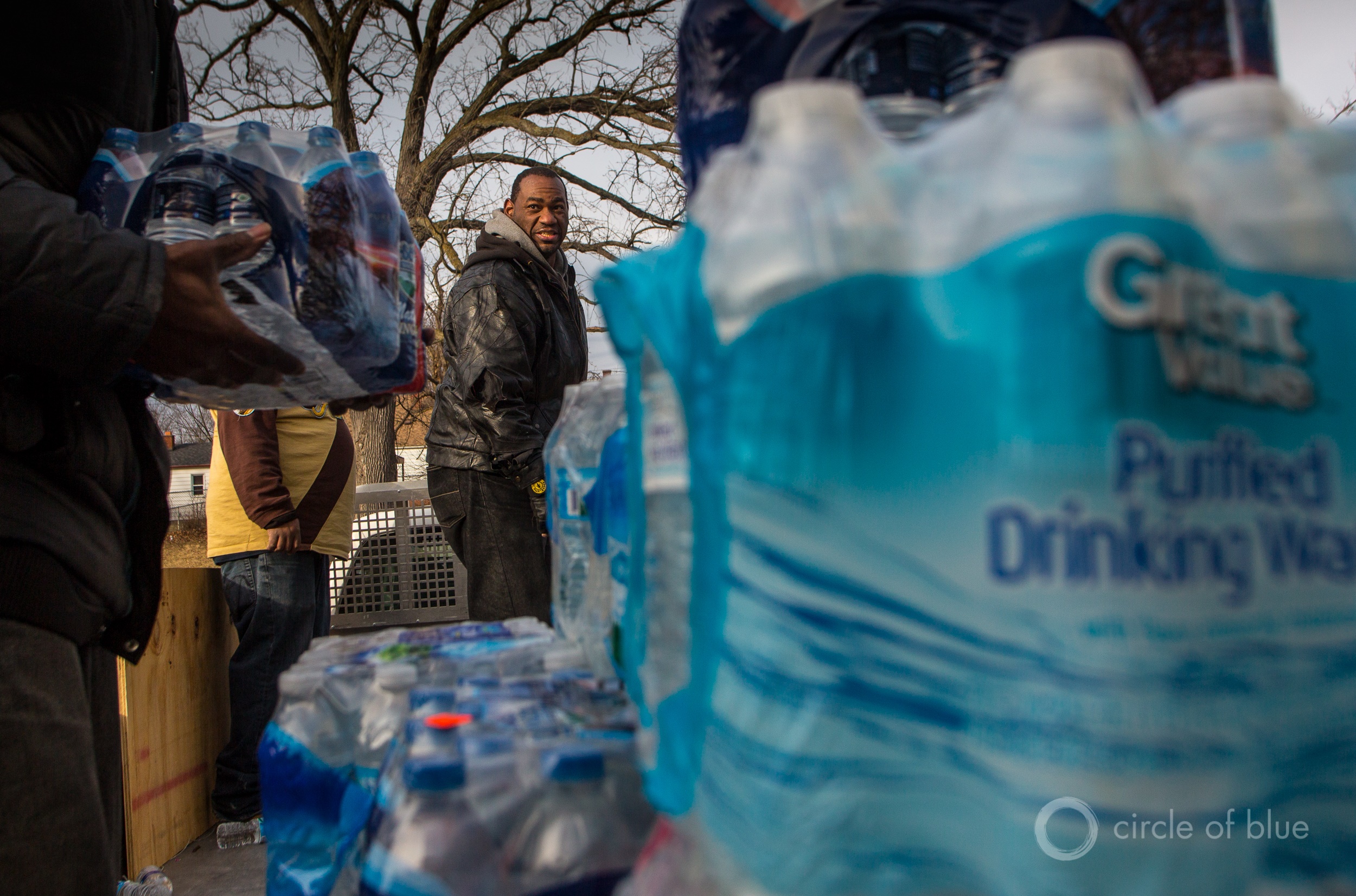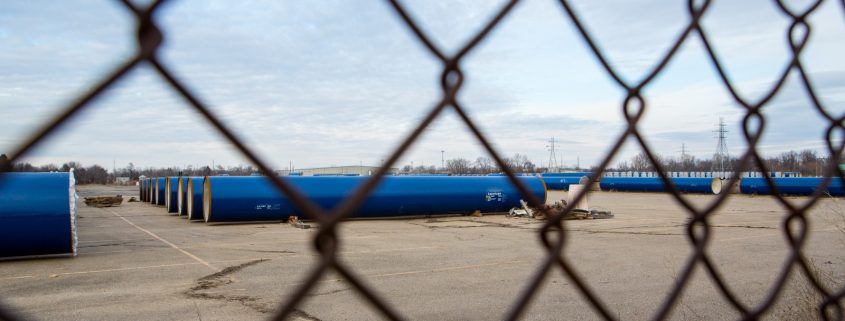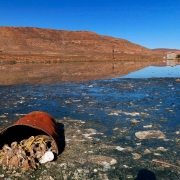2017 Preview: Flint Lead and Infrastructure Troubles Remain
Flint drinking water is not the wreck it was, but it is still not lead-free.

Residents unload bottled water at a distribution center in Flint, Michigan, on February 6, 2016. Flint residents still drink bottled water but its water system now passes the federal lead standard. Photo © J. Carl Ganter / Circle of Blue
By Brett Walton, Circle of Blue
2017 will be a year of transition for Flint.
The city pivots from an emergency response to elevated lead levels in drinking water and children’s blood to something more mundane: long-term management of a chronic public health and infrastructure problem.
Flint’s entire system — water mains and lead laterals that connect to homes — needs repair, says Marc Edwards, the Virginia Tech professor who helped bring Flint’s dirty water to national attention. The federal government approved in December $US 100 million for lead pipe replacement. City and state officials face difficult choices about how to spend the money for the most public benefit.
“Even if we wave a magic wand and the lead pipes go away, Flint still has an infrastructure crisis,” Edwards told Circle of Blue.
Its population cut in half since the 1960s, Flint continues to see residents flee. With fewer people to pay for maintenance of aging water mains, the city has one of the highest water rates in the nation. Main breaks invite contaminants into the water pipes. Stagnant water in pipes breeds disease, like the Legionnaires outbreak that killed a dozen people in the Flint area starting in 2014. None of those troubles will be fixed just by replacing lead laterals, Edwards says.
Several measures in the last year and a half largely tamed the astronomical levels of lead in household drinking water. Flint reconnected with Detroit’s water system and applied a coat of organophosphates to the insides of water mains to minimize pipe corrosion.
Testing by the U.S. Environmental Protection Agency, Michigan Department of Environmental Quality, and Virginia Tech show that the actions reduced lead concentrations to the point that Flint now meets federal regulations. More than 90 percent of tested homes — the threshold for passing the federal Lead and Copper Rule — are under the 15 parts per billion (ppb) standard. The Michigan Department of Environmental Quality’s most recent sampling results, conducted on November 17, showed only 10 of 149 homes with lead levels above 15 ppb.
Faucet filters, meanwhile, have proven remarkably adept at removing lead. All faucet filters tested by the EPA registered less than 1 ppb. Edwards said he endorses certified filters “without reservations.” According to the Michigan Emergency Management and Homeland Security Division, more than 97 percent of Flint households have picked up a filter, provided by the state.
Change to Federal Lead Rules Coming Soon
Flint water passes federal regulations, but critics contend that the EPA’s Lead and Copper Rule is a flawed standard. One reason is that single tests do not reveal a full picture. A house on Thomson Street, for instance, had lead levels at 3 ppb or below during the four Department of Environmental Quality sampling rounds that began in May 2016. For the fifth round, conducted on September 21, levels climbed to 68 ppb. For the sixth round, levels spiked to 5,986 ppb. A number of factors could account for the rise: neighborhood construction that loosens flecks of lead or stagnant water in the pipes, to name two.
EPA scientists, on the other hand, take 10 to 20 samples at each house. The lead concentration pattern varies house by house. Most of the samples spike in the first few samples then taper. But some show multiple peaks, and others spike in the tenth sample or later.
Another objection to the federal rule is that inequality is built into its design. Up to 10 percent of tested homes are allowed to have high lead levels before the utility is in violation, despite the EPA’s assertion that no amount of lead is safe. The Lead and Copper Rule is therefore not a measure of safety, argues Yanna Lambrinidou, founder of Parents for Nontoxic Alternatives, an environmental health group, and member of the EPA advisory committee for lead in drinking water. Rather, it is an indicator of a utility’s power to select homes for testing, to oversee the sampling, and to ignore high lead levels at individual homes, she told Circle of Blue.
The EPA is under pressure to change course. The agency is developing the first major revision of the Lead and Copper Rule since 1991. Minimizing lead exposure and adding stricter testing requirements are key principles, according to the agency’s October 2016 white paper. A draft version is expected in June and a final rule by the end of 2018.
Brett writes about agriculture, energy, infrastructure, and the politics and economics of water in the United States. He also writes the Federal Water Tap, Circle of Blue’s weekly digest of U.S. government water news. He is the winner of two Society of Environmental Journalists reporting awards, one of the top honors in American environmental journalism: first place for explanatory reporting for a series on septic system pollution in the United States(2016) and third place for beat reporting in a small market (2014). He received the Sierra Club’s Distinguished Service Award in 2018. Brett lives in Seattle, where he hikes the mountains and bakes pies. Contact Brett Walton












